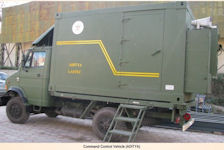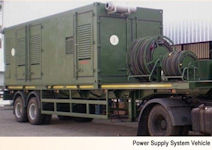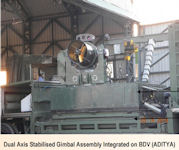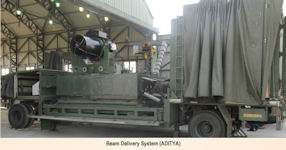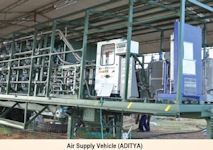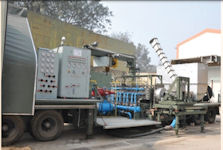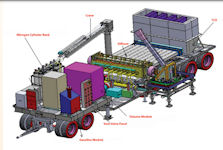DRDO/LASTEC 100KW Aditya
DRDO had a 100KW laser named ADITYA. This Gas Dynamic Laser was not mobileble, though mounted on wheeled vehicles it was tranportable, and had a lot of complex plumbing. Lasers have become an indispensable part of the modern day battlefield. Depending on the wavelength and power; lasers have wide spectrum of military applications from dazzling human eye to shooting down a UAV, guiding munitions for precision strike, imaging enemy targets and detecting chemical, biological and explosive materials.
Since the development of the first working lasers, considerable time and effort has been expended in the search for higher output laser systems. The possible applications of high power lasers are unlimited in the fields of communication, manufacturing, construction, medicine, space exploration, and defense. Unfortunately many obstacles exist to the attainment of high power systems. Most lasers have a low efficiency and therefore to obtain high power or high energy outputs, considerably more energy must be furnished to the system than is extracted. If this energy furnished is electrical, then the system cannot have a large average power and still be portable, as is desired in some cases. The relative size and weight of laser systems, and the availability of materials, have also introduced obstacles to their development.
The gas dynamic laser has grown out of the initial laser effort and is representative of one of the more sophisticated laser techniques which has the capability of providing very high power radiation output, due primarily to the large gas handling capability characteristic of such a system and due to the large quantity of energy which can be added to the gases flowing in such systems.
The name Aditya is primarily a male name of Indian origin that means Descendant Of Aditi. Aditya is one of the Hindu gods who are children of Aditi. Aditya is another name for the sun god Surya. According to the Rigveda, the Adityas are the 7 sons of Aditi. These celestial beings are Varuna, Mitra (or Surya), Aryaman, Bhaga, Amsa, Dhatri and Indra. Aditi had an eighth Aditya as well, called Martanda, who she rejected and disowned.
The Brahmanas, which are commentaries on the 4 Vedas, list the existence of 12 Adityas, as Amsa, Aryaman, Bhaga, Daksha, Dhatri, Indra, Mitra, Ravi, Savitr, Arka (or Surya), Varuna and Yama. In the Chandogya-Upanishad, Aditya is another name of Vishnu, in his fifth avatara as Vamana, the Dwarf. Interestingly, Vamana's mother, according to this Purana, is Aditi. One other list from the Vishnu Purana names 12 Adityas, as Amsa, Aryaman, Bhaga, Dhuti, Mitra, Pusan, Sakra, Savitr, Tvastr, Varuna, Vishnu and Vivasvat.
DRDO's Laser Science and Technology Centre (LASTEC) is working for the development of laser source technologies for Directed Energy Weapon (DEW), dazzling and imaging applications. It is developing standalone sensor systems using different laser sources for applications like detection and location of optical targets and detection and identification of chemical, biological and explosive materials. Other laser systems developed by LASTEC include unexploded ordnance disposal system and different variants of dazzlers. LASTEC is also working in the area of electro-optic countermeasure systems and development of laser materials.
Over the years, LASTEC has acquired the expertise in designing, testing and evaluation of different types of laser sources and systems. Gas Dynamic Laser and Chemical Oxygen and Iodine Laser Sources of the order of tens to hundreds of kilowatts for DEW application have been successfully developed and demonstrated. By 2015, single mode kW class Fiber Laser Source was realised in collaboration with foreign experts making India only the 6th (known) country to possess the requisite technological knowhow. Efforts are channelised in scaling the power levels of these laser sources.
In 2015 LASTEC's ADITYA project was an experimental test bed to seed the critical DEW technologies. The Gas Dynamic High Power laser based Directed Energy System can be broadly divided into two major subsystems: Laser Power Source and Beam Delivery System. Laser power of the order of 100 kW is required to cause the stipulated damages at 0.8 km and 2.5 km distance using a 0.7 m aperture telescope. The beam delivery system has to simultaneously perform several roles. It acquires and tracks the distant static and moving target in real time and points and focuses the laser beam on the target. The adaptive optical system has to compensate for the jitter and wave front distortion of the laser beam from the source.
The 100 kW Laser Power Source consists of system integrated on different transportable platform, viz., Laser Generation System Vehicle (LGV) and Air Supply System Vehicle (ASV). A trailer based system for generating; storing and delivering high-pressure compressed air has been realized for project ‘Aditya’. The system is under integration and testing. The system has been realised, integrated, and tested. Laser power of the order of 100 kW has been achieved. Damage potential of the laser has been tested up to 800 m distance.
Laser Generation Vehicle (LGV) has been developed to generate a high energy beam. The input energy is pumped into the system through combustion of large amount of air and toluene. The system mainly consists of laser tunnel, toluene storage, gasoline storage and pressurisation and feed system, parts of combustion, ignition, aerodynamic window, cavity bleed, fuel purging, pneumatic air supply lines, control panel, etc. The laser tunnel consists of a combustor, a nozzle bank with cavity, resonator, diffuser and TCD. These systems are mounted on a low bedded transportable trailer having suitable canopy. The LGV is dependent on ASV for oxidiser air supply and command control vehicle for operation commands for generation of high energy beam.
A high power gas dynamic laser (GDL) involves large mass flow rate of gases expanding through short throat, short length nozzles into the cavity to achieve laser action with required power level. Non-laminar flow of gases in the laser cavity brings inhomogeneities in lasing medium resulting in degradation of wavefront quality of output laser beam. Moreover, mechanical and acoustical vibrations of the optical components and the platform supporting these components generate high frequency beam jitter. An adaptive optical system is, in general, used to correct the localized wavefront errors and the beam drift/ jitter.
The beam from laser source is coupled to the beam delivery system. The focusing telescope is mounted on a gimbal which should be agile enough to keep the beam focused on the same spot. The gimbal has to work in closed loop with video tracking system. The main objective of the Beam Directing System (BDS) of Project ADITYA is the auto focusing of the high power laser beam onto a distant moving target in the required operating range. The BDS consists of mainly two assemblies, one is beam transport system and other is stabilised gimbal platform assembly.
The beam was focused on the far field targets with the help of Basic Beam Director (BBD) and gimbaled telescope mounted on the Beam Delivery System Vehicle (BDV). Damage potential on various types of targets (stacks of mild steel plates, perspex, GFRP, optical glass, etc.) has been established. The technology related to laser source, beam delivery and issues related to system integration on mobile platforms have been addressed during the execution of the project. It would be a useful input to future laser weapon programs of DRDO.
|
NEWSLETTER
|
| Join the GlobalSecurity.org mailing list |
|
|
|


